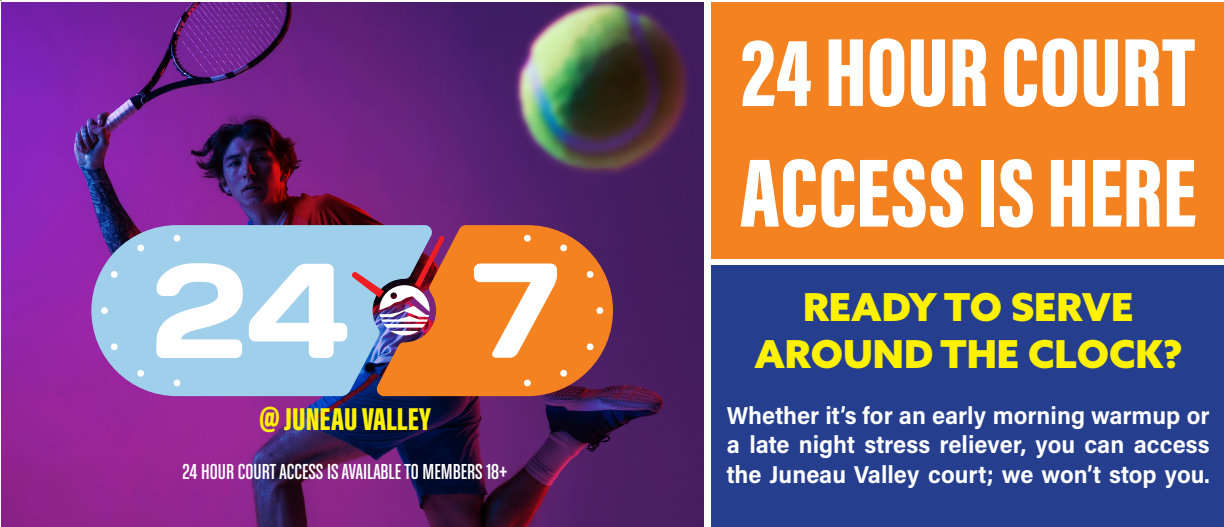- South Club: 11:00am - 2:30pm
- Eagle River: 9:30am - 11:30am
- Juneau Valley: 11:00am - 1:00pm
- Wasilla Club: 8:00am - 10:00am

Southcentral Clubs:
All our listed times are for pick-up play except for our South Anchorage gym 11am-12:30 pm Fridays which is designated for Pickleball Workshops. Members are welcome to attend any of the pick-up times. We provide nets and balls as well as a few paddles. Once you’ve played for a few times, you will want to purchase your own paddle based on your personal preference.
Juneau Valley:
Our Juneau Valley Club offers a variety of scheduled pick-up times and options for reservations. Members and guests can come in during pick-up sessions where seasoned players are normally on hand to assist newcomers to the sport. We supply the nets, but please be sure to bring your own paddles and balls. Additionally, after-hours play is available for those aged 18+ on a first-come, first-served basis.
*Guests must be accompanied by a member or check into the membership office before playing.

Sign up for a Pickleball class by clicking on the sign-up button and following the sign-up instructions. If you need assistance with registering contact
Learn how to play pickleball including scoring, serving, footwork, and general strategy. Bring your paddle if you have one but you can use one of ours if you don't.
This workshop is for those that have taken the intro workshop but are newer to the game of Pickleball. We will review the scoring, rules and expand upon the strategy.
This workshop is designed for those experienced in pickleball to increase their skill level by working on aspects of the game such as serving, footwork, teamwork, and that all-important 3rd shot. Be prepared to play to incorporate and fine-tune skills being reviewed.
This fun sport combines many elements of tennis, badminton, and ping-pong. Pickleball can be played both indoors or outdoors on a badminton-sized court and a slightly modified tennis net with a paddle and a plastic ball with holes. Team up with a partner for doubles, or play one-on-one singles.
According to USAPA, there are over 15,000 indoor and outdoor courts in the United States; and at least one location in all 50 states. Pickleball is being introduced to kids in teenagers in physical education classes in middle and high schools. And though the sport has become more competitive through the years, many players enjoy the social aspects of the game and the ability to stay active in their own towns and communities.
As more retirement locations have adopted pickleball as an integrated sports activity for their population of residents, we have seen an explosion of new court construction throughout the United States – especially in the southern states. Tennis, racquetball, and ping pong players love the competitive nature of the sport and regularly participate in local, regional, and national tournaments.
The Serve
Service Sequence
*At the beginning of each new game only one partner on the serving team has the opportunity to serve before faulting, after which the service passes to the receiving team.
Scoring
Double-Bounce Rule
Non-Volley Zone
Line Calls
Faults
Determining Serving Team
Players use any fair method to determine who will serve first, such as picking number 1 or 2 written on the back of the score-sheet in a tournament. The winner has the option to choose side, or to serve or receive. In recreational play local players or clubs often designate a particular end of the court (e.g., north side) as the side to serve first.
Pickleball was invented in 1965 on Bainbridge Island, a short ferry ride from Seattle, Washington. Three dads – Joel Pritchard, Bill Bell, and Barney McCallum — whose kids were bored with their usual summertime activities — are credited for creating game. Pickleball has evolved from original handmade equipment and simple rules into a popular sport throughout the US and Canada. The game is growing internationally as well, with many European and Asian countries adding courts.
A pickleball court is the same size as a doubles badminton court and measures 20×44 feet. In pickleball, the same court is used for both singles and doubles play. The net height is 36 inches at the sidelines and 34 inches in the middle. The court is striped similar to a tennis court with right and left service courts and a 7-foot non-volley zone in front of the net (referred to as the “kitchen”). Courts can be constructed specifically for pickleball or they can be converted using existing tennis or badminton courts.
When playing pickleball, each player will need a pickleball paddle, which is smaller than a tennis racquet but larger than a ping-pong paddle. Originally, paddles were made only from wood, however, today’s paddles have evolved dramatically and are primarily made of lightweight composite materials, including aluminum and graphite. Players will also need a net and a pickleball. The ball is unique, with holes through it like a whiffle ball. Different ball models are intended for indoor and outdoor play. Balls come in several colors, including white, yellow and green, but must be a single color to meet International Federation of Pickleball (IFP) specifications.